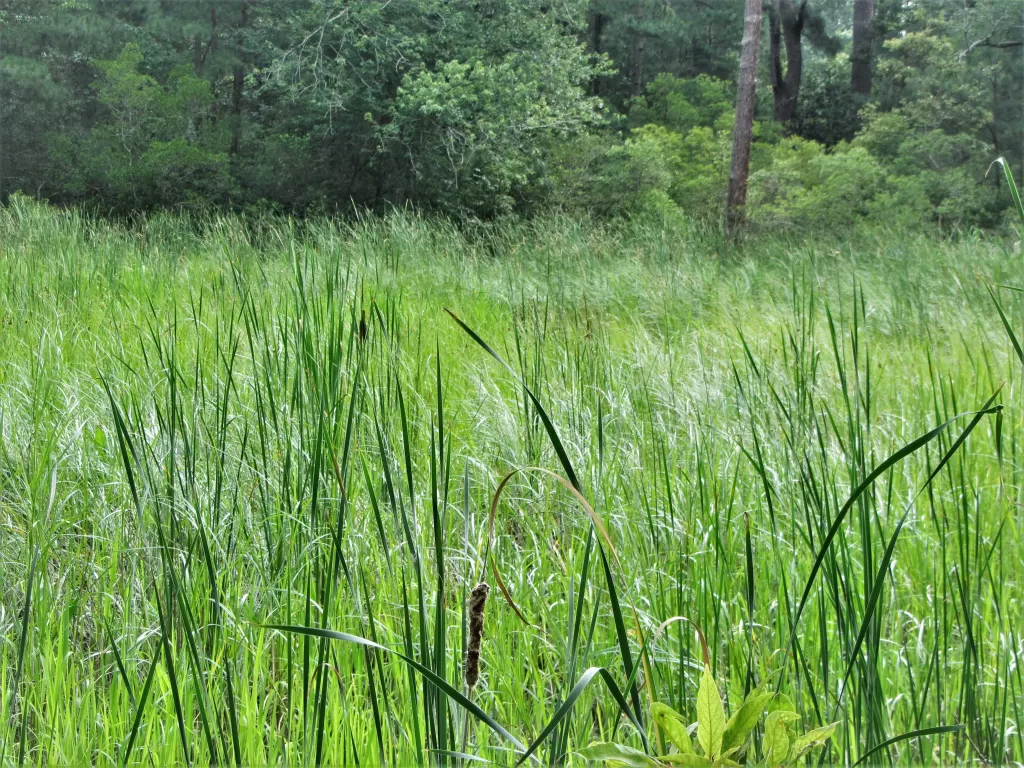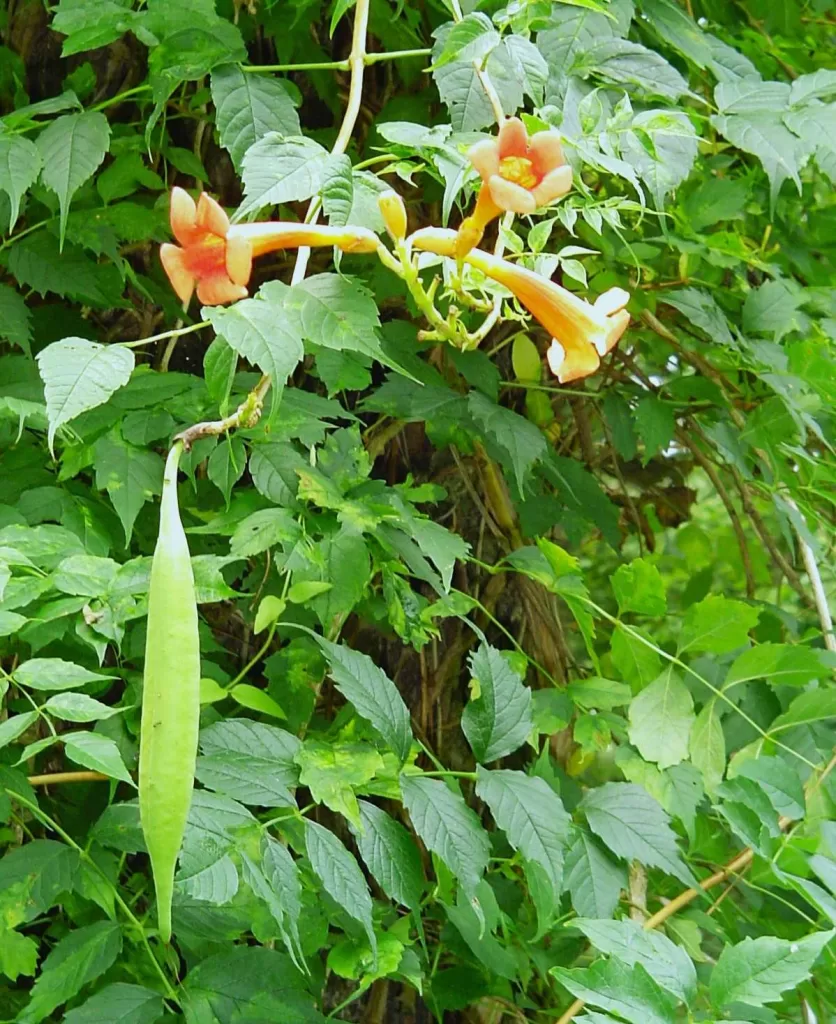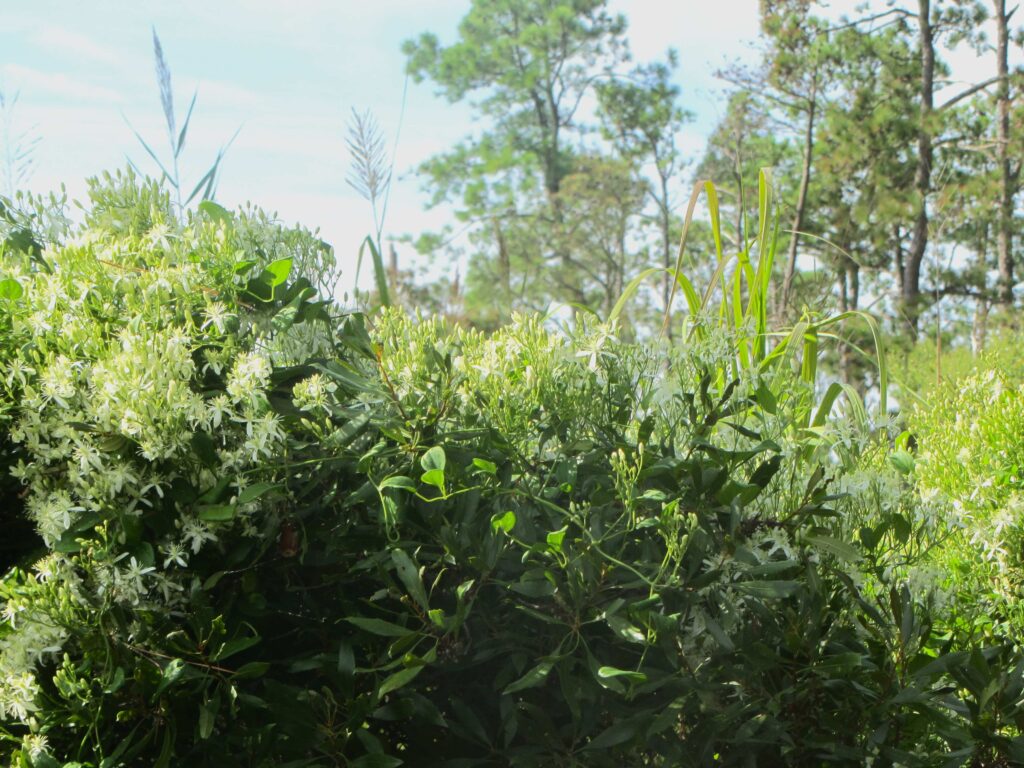Summer Wildflowers on Jamestown Island
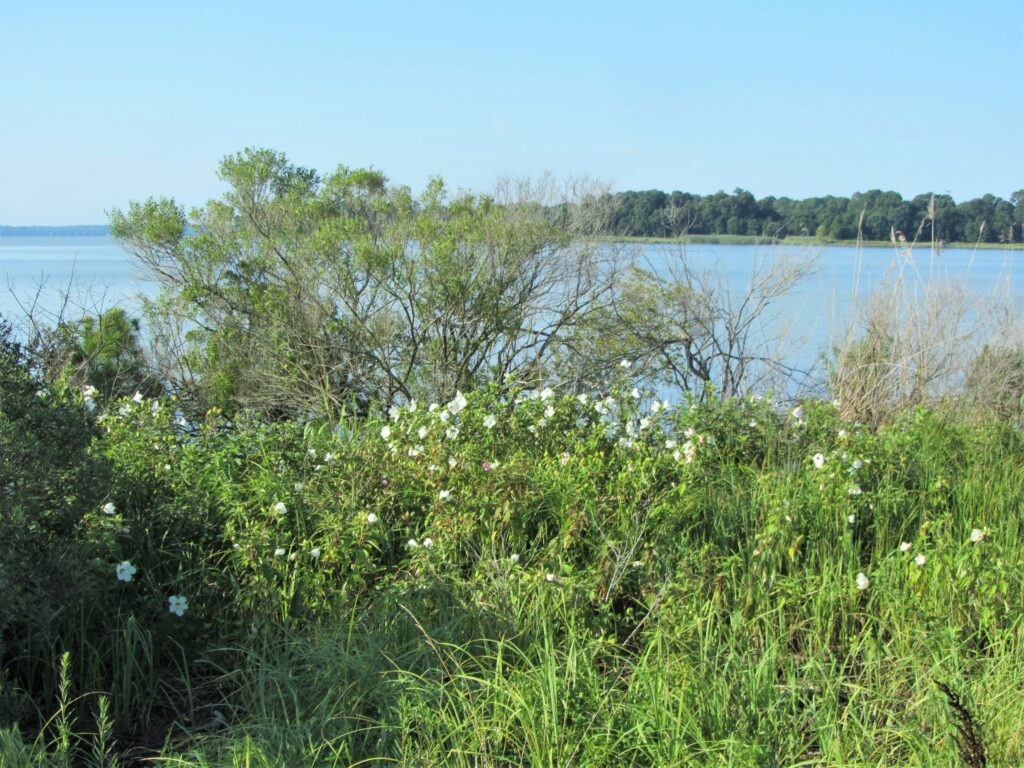
Jamestown Island is visible across The Thorofare, a portion of the James River between the island and the mainland, near present day Archer’s Hope. Native Hibiscus laevis bloom along the river in summer.
May, 1607
Jamestown Island was uninhabited and covered in native vegetation in May of 1607 when the first English settlers chose to establish their colony on a small peninsula in the Powhatan River, now the James River. That peninsula, along with most of the shoreline of the lower river, was under the control of the Powhatan Chiefdom, a confederation of thirty tribes by that time, based to the north at Werowocomoco, in what is now Gloucester County. This chiefdom of allied tribes encompassed much of Eastern Virginia, including parts of the Eastern Shore. These native Virginians recognized that while the forested island was good for hunting, it was not a good place to live. Archeological evidence reveals that the area was inhabited by native Americans up until around 2000 years ago, when climatic conditions shifted. As glaciers melted, brackish water from the river rose, and overwhelmed the freshwater streams on the peninsula, to create conditions similar to what we can observer today.
When The Virginia Company’s three ships first entered the Powhatan (James) River near the mouth of the Chesapeake Bay, they encountered beautiful, productive land at Kecoughtan, now Hampton, a native American settlement led by Chief Powhatan’s son, Pochins. After encountering these first native Americans, who welcomed them, they continued up the river for another 35 miles looking for a place to settle that would be defensible should the Spanish attack.

Waterways wind through Jamestown Island. This tidal, brackish water is not good for drinking and supports few fish or shellfish. Cattails and white flowering duck potato bloom in the marsh. Mostly pines and Myrica line the shores of the marsh.
A Fateful Decision, or Location is Everything
Leaders of the expedition debated whether to establish their settlement at the mouth of College Creek, still called ‘Archer’s Hope’ for Gabriel Archer, who believed that would be the best place to establish their fort. Today there is a public beach and parking area at Archer’s Hope, along the Colonial Parkway. But Captain Christopher Newport and Captain Bartholomew Gosnold, and others, insisted on finding a more defensible site with more visibility of the river. They also needed a place with deep water, close to land, to anchor their ships. That is why the colonists off-loaded their ships and established their settlement on the nearby peninsula, which was nearly cut off from the mainland by Back River.
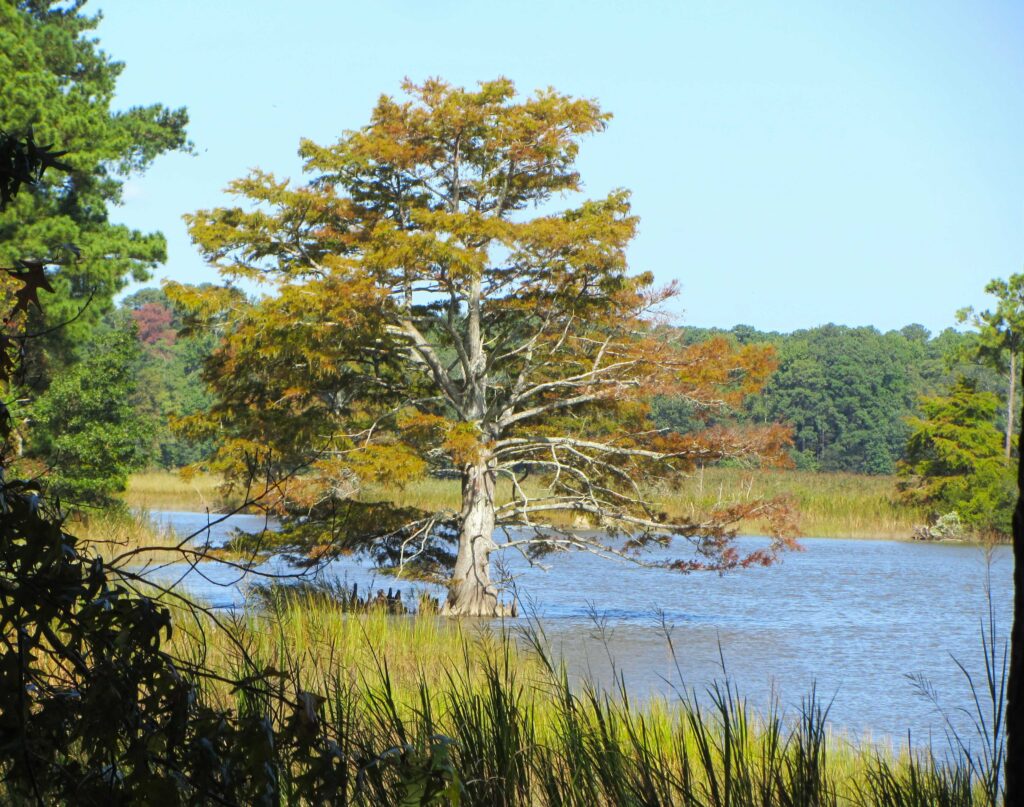
A bald cypress tree, Taxodium distychum, grow in Back River, near the historic settlement site.
What was once a peninsula is now known as Jamestown Island, in honor of King James I, who had granted the charter to the Virginia Company of London. The current isthmus and bridge which connect this land to the mainland, no matter the tide, were built in 1956. If only the colonists had chosen ‘Archer’s Hope, near present day Kingsmill, things may have gone differently for the Jamestown settlement.
Early settlers found mature hardwood forests covering the higher elevations on Jamestown Island. Oaks, hickories, bald cypress, red cedar, walnut, sweet gum and other hardwood trees dominated, with pine trees also growing along waterways and small clearings. Captain John Smith reported, “… the ground all flowing over with faire flowers of sundry colours and kindes, as though it had beene in any Garden or Orchard in England. There be many Strawberries, and other fruits unknowne.”
Low-Lying Wetlands and Rising Tides
Jamestown Island is low and swampy, cut through with brackish waterways and a pitch-tar swamp. Half of its 1560 acres are covered with wetlands. Most of the island is no more than 2’ above mean high tide, and the areas of greatest elevation are the earthworks left from the American Civil War. Standing water on the island today is dark, and often has an oily sheen. Run-off after a heavy rain lingers in low-lying areas, but there are no longer any natural springs or seeps on the island. Sea level rise after the last ice age had already raised the water levels in this area so that sources of freshwater were scarce and seasonal by 1607, frequently inundated by brackish water from the river. Archeologists and geologists tell us that the James River has risen by about 3′ in the four centuries since colonization began.
The shallow wells that settlers constructed were vulnerable to salty, brackish ground water and sometimes drew water from the polluted water of the pitch-tar swamp. Severe drought from 1606 through 1612, as documented in tree rings, left the water of the James River more salty than usual, so the colonists were without pure drinking water. This led many of the early settlers to fall ill and die of water borne diseases like typhoid and dysentery.
Wetlands Dominate the Island Today
Visitors to the island today, driving on the National Park Service’s ‘Loop Road,’ will observe the standing water along the sides of the road, the mucky swamps, the several channels cutting across the island, and the lack of larger wildlife living there. While deer once roamed the island, eating much of the ground cover layer of vegetation and sapling trees, they are rare today. Visitors will commonly observe turtles, frogs, many types of insects, several bird species, and crabs in the marshes. One rarely sees the deer, rabbits, squirrels, or other mammals common along the Colonial Parkway. Just as in the early 17th century, Jamestown Island’s air is abuzz with mosquitoes and flies. Ticks and chiggers live in the vegetation. It is important to use insect repellents to avoid taking home painful ‘souvenirs’ of the visit.
Significant sea level rise over the past century continues to accelerate noticeably on the island, raising groundwater and the water level in the pitch-tar swamps even faster than the river is rising on the island’s perimeter. A USGS stake planted on the eastern tip of the island at Black Point in the late 1980s now stands in the river, several feet offshore from the current tidal beach. Even though this end of the island was reinforced with rock revetments in the early 2000s, erosion has continued, and over an acre of land on this end of the island now is permanently submerged.
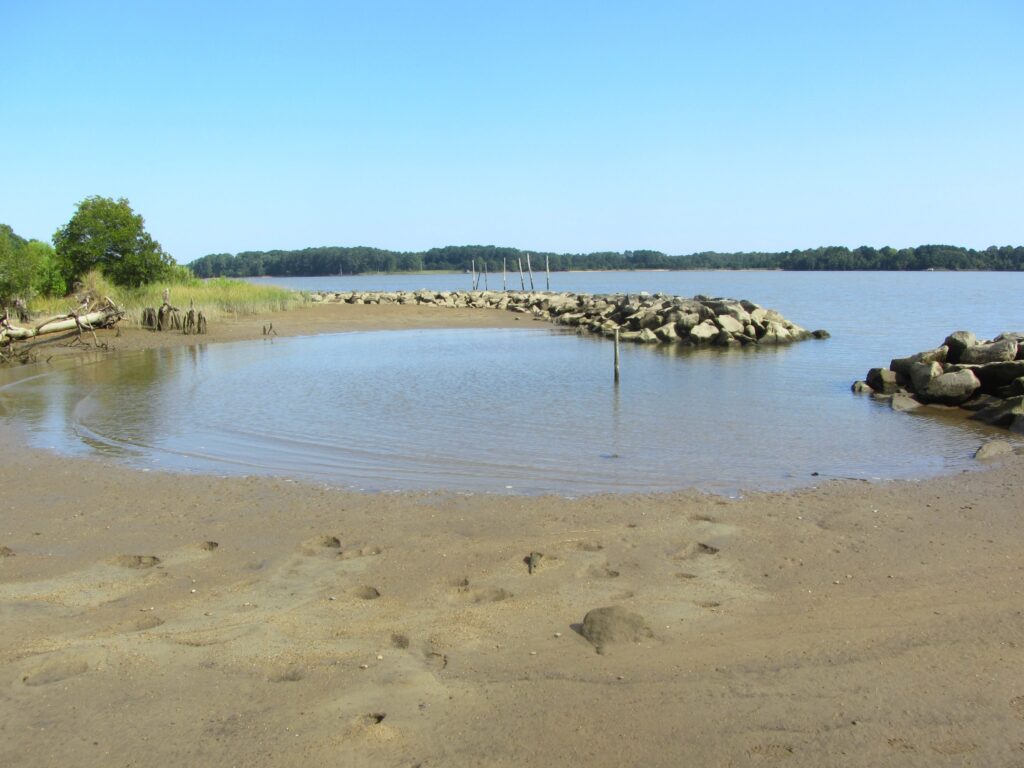
The marker set on dry land at the end of Black Point by the USGS in the 1980s now stands well offshore. This photo, taken at low tide, shows some of the remains of the ‘ghost forest’ where trees have died as the James River has risen on the shoreline. The rocky revetment shows where the river met the shore 40 years ago.
Even more important than the loss of dry land is the effect of rising water levels on the existing forests. Brackish water, occasional flooding, and saturated soil steadily kill mature trees on the island. Root rot, and other fungal diseases, attack many trees and the roots can’t breathe in saturated soils. ‘Ghost forests’ of pine trees line this eastern end of the island, and one notices the dead and dying trees throughout all parts of the island today.
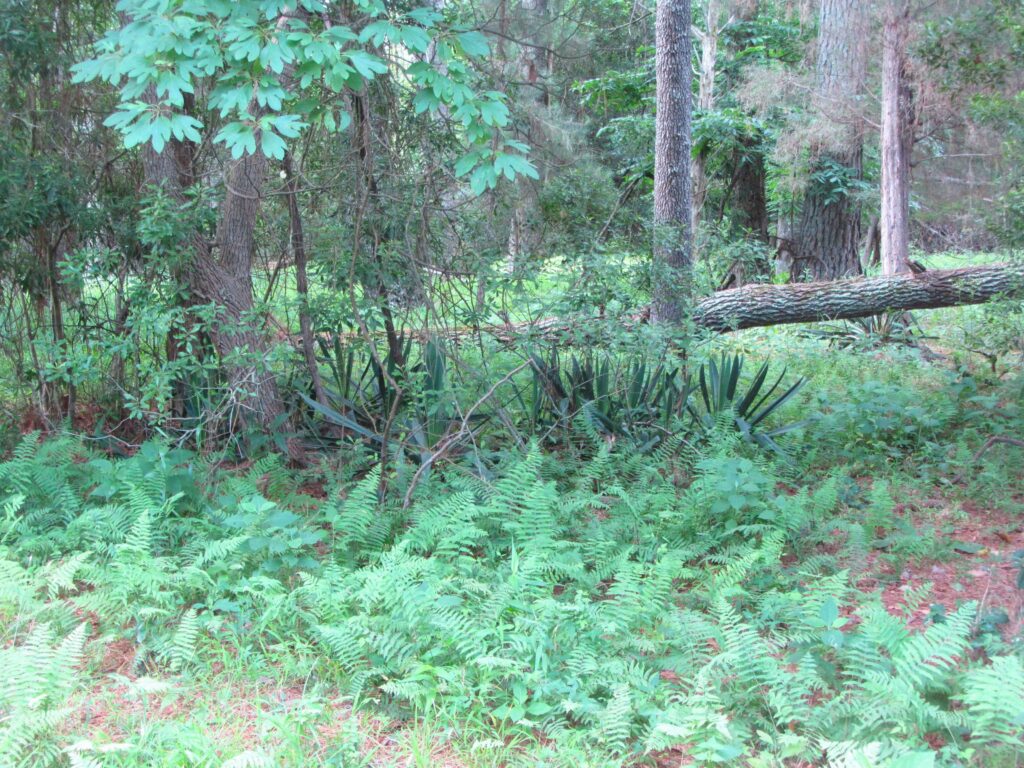
Eastern marsh ferns, Thelypteris palustris, grow along the edges of the loop road and in the clearings as ground cover. They can grow in full to partial sun so long as they grow in moist soil. The upright leaves of Yucca filamentosa can be seen in clearings throughout the island, though they rarely bloom. A Sassafrass tree in the foreground shades this planting. Fallen and dying trees are a common sight on the island today.
Agriculture on Jamestown Island
The early colonists began planting crops to feed themselves during the first few years of the Jamestown settlement, with little success. It was late for planting by the time they arrived in mid-May of 1607, and their first task was building the palisades and bulwarks to protect their settlement because native Americans first attacked the settlement within a few days of their landing. Their main mission was to search for gold and turn a profit, but the colony’s leaders also knew that they had to eat. Priorities were conflicted among the settlers. But drought and the nature of the island made growing food difficult, even with later assistance from Native Americans. Captain Newport returned to England for more supplies, taking a crew with him, a few months after the Virginia Company’s first landing.
At first, the settlers at Jamestown tried to grow food mostly inside their small fort. Eventually, agriculture spread to nearby areas along the river and land on the island was cleared of trees for cultivation. Agriculture was widespread on the island by the early 18th century, after the capital of the Virginia colony moved further inland to Williamsburg in 1699. The Travis and Ambler families continued farming on their land, even after the earlier settlements on the island were destroyed during fires by 1700. Other than these two families, it remained mostly uninhabited by any sort of town, after the fires.
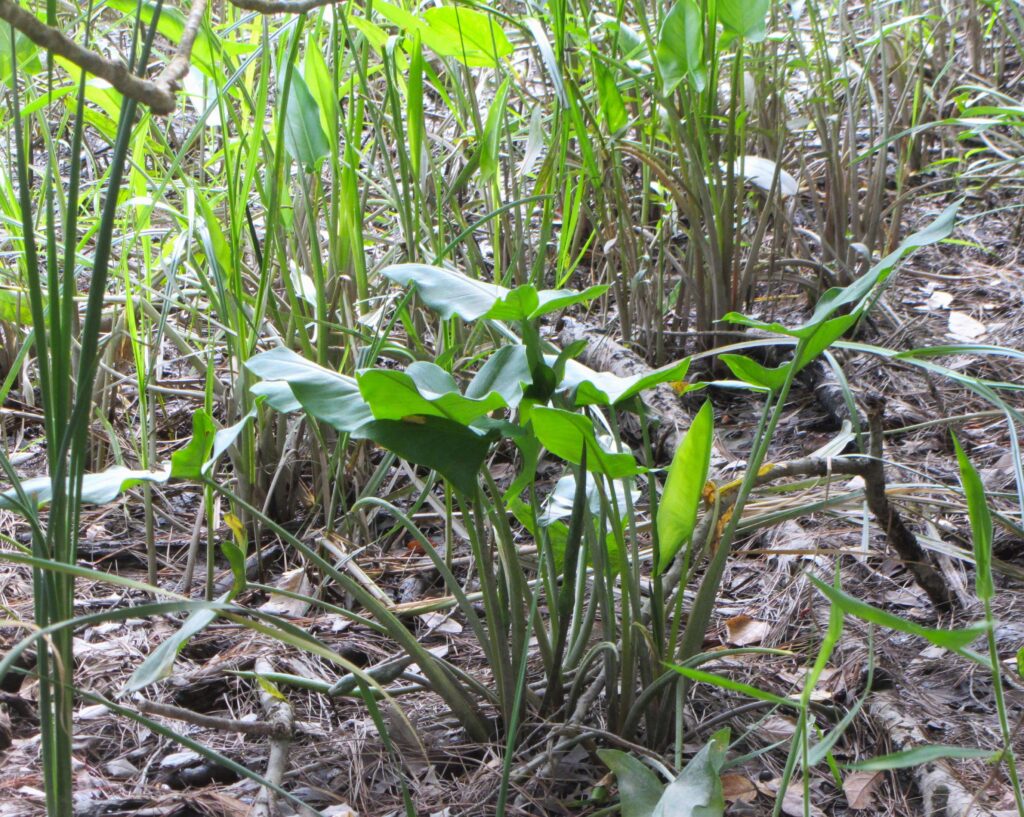
Pickerelweed is one of several edible wild plants growing on Jamestown Island. Its leaves may be eaten raw, and its seeds maybe eaten fresh or dried, cooked, ground into flour, or fresh out of hand. All parts of this plant are edible. Even its rhizomes may be eaten after they are boiled. It is unknown whether the first settlers knew they could eat this plant, along with the cattails and duck potatoes growing in the swamps on the island. They could also gather walnuts, persimmons, blackberries, wild strawberries, acorns, and other naturally occurring native foods.
Fort, Farm, and Archeological Site
Jamestown Island was used as a military post during both the American Revolution and the Civil War. It was owned by Mr. and Mrs. Edward Barney by the late 19th century, when they gave 22.5 acres to the Association for the Preservation of Virginia Antiquities (now Preservation Virginia) to preserve the original settlement on the western shore of the island in 1893. With federal help, a sea wall was built in 1900 to protect this historic site. They sold the rest of the island to the National Park Service in 1934. This history leaves Jamestown Island uniquely wild and populated primarily by native plant species today.

Magnolia grandiflora trees bloom on Jamestown Island today in May through August, though it would have been too cold for them to survive in the early 17th century. Magnolia virginiana was still growing on the island in 1970.
The Changing Forest
While the original ‘old growth’ forests were cleared or burned multiple times between 1607 and 1934, the tree, fern, and wildflower species growing today are largely native. Magnolia grandiflora, which blooms all summer, originally grew only further to the south in the Carolinas. This majestic tree species now grows on the island since our climate has warmed since the 17th century. Common trees on the island today include several species of pine, a pioneer tree species which grows quickly on cleared land; Virginia red cedar; bald cypress; all three eastern species of Myrica, or wax myrtle; tulip trees; swamp bay; American holly; persimmon; sweet gum; Sassafras, red maple; black walnut; black gum; hickory; and several species of oak. Beautyberry shrubs are common along the roadsides.
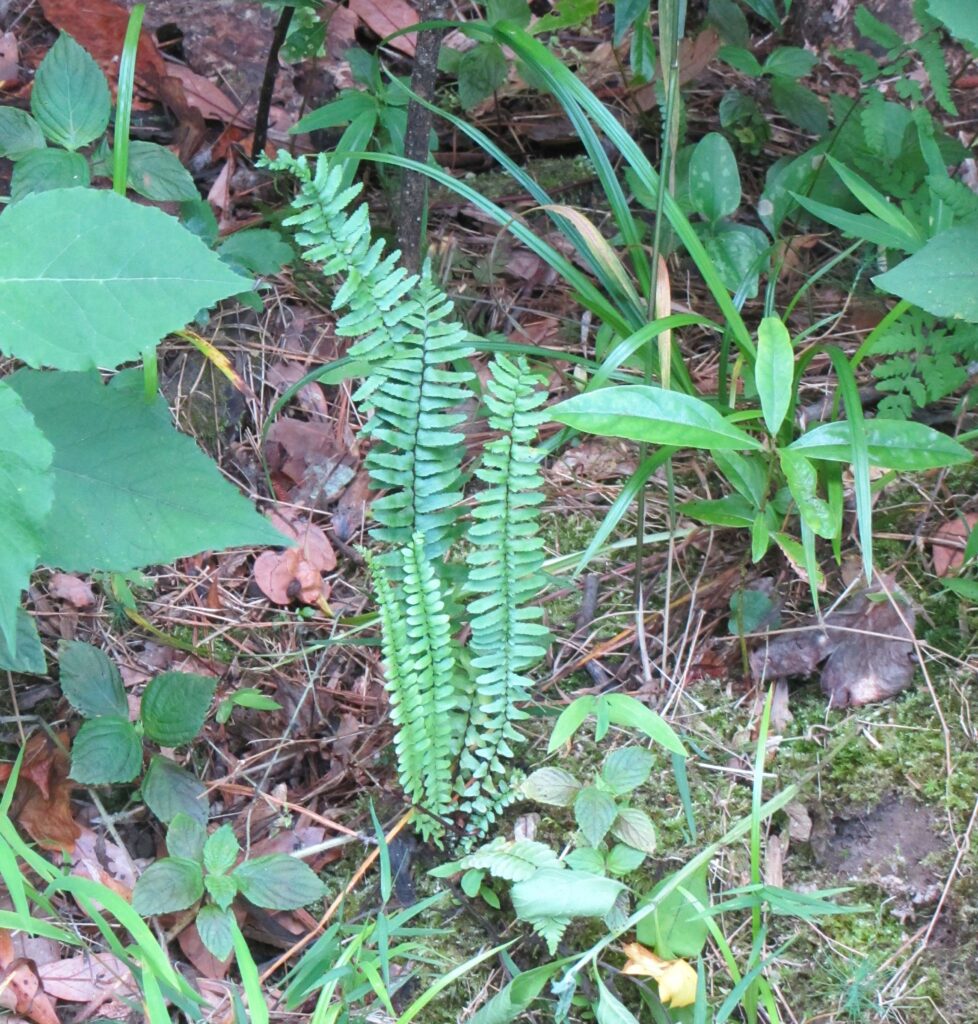
Ebony Spleenwort, Asplenium platyneuron, grows with moss, grasses, other native plants, and with lady fern, Athyrium filix-femina, in the background.
Native Ferns on Jamestown Island
Several fern species grow wild on the island, especially along the moist shoulders of the Loop Road when the Park Service doesn’t mow in early summer. Stands of deciduous ferns, particularly Eastern marsh ferns, Thelypteris palustris ; netted chainfern, Woodwardia areolata; and Southern lady ferns, Athyrium asplenioides; carpet the roadsides and forest floor from spring through fall. Evergreen Christmas ferns, Polystichum acrostichoides, grow as ground cover in the drier wooded areas and along the earthworks left from the Civil War. It glows in the winter sunlight beneath American hollies and Southern Magnolias and Eastern red cedars through the fall and winter months. Ebony spleenwort, Asplenium platyneuron, can be found colonizing more open areas among grasses and wildflowers throughout the year.

Woodwardia areolata, netted chain fern, grows in partial sun to shade in moist soils where it spreads on its rhizomes to form a thick ground cover. It is a deciduous fern commonly found growing along the sides of the Loop Road on Jamestown Island.
How to Enjoy Jamestown Island’s Plant Life
Visitors to Jamestown Island may walk on the island’s Loop Road, bike, or drive when the road is open to motor traffic. The road carries visitors through many of the various vegetative zones, including forests, clearings, and wetlands. By late summer, visitors can enjoy a variety of ferns and several native wildflowers blooming on the island, in addition to the Magnolia blossoms.
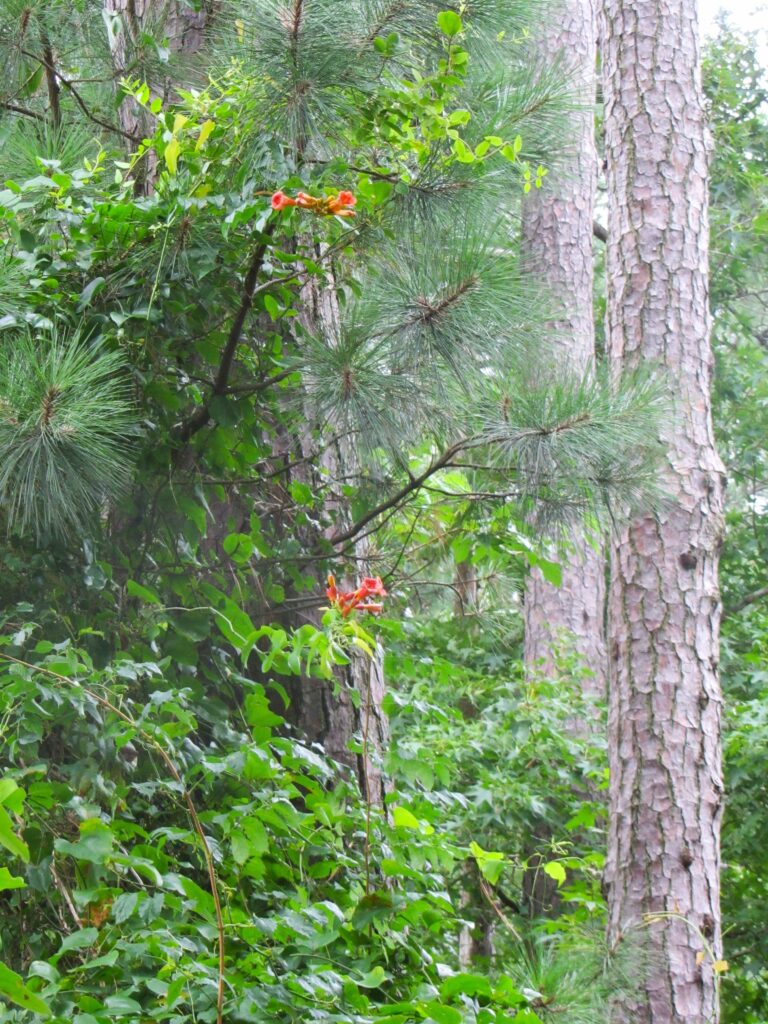
Trumpet vine blooms as it climbs trees on the island, but its foliage may also be found creeping along the ground on roadsides. It takes 3 to 5 years for a young vine to bloom for the first time. “First it sleeps, then it creeps, before it leaps!”
Summer Wildflowers on Jamestown Island
Trumpet vines, Campis radicans, wind their way up the trunks of trees and scramble over shrubs, blooming with bright orange trumpet shaped flowers in partial shade to full sun. These showy flowers attract insects and hummingbirds to their abundant nectar. Deer and other mammals can eat their leaves, which are deciduous. Vines spread freely by the seeds produced in pods, as well as by suckers.
Mature vines grow to 40’ tall and 10’ wide, growing very heavy with time, which can eventually choke out the trees on which they grow. These showy orange or yellow flowers stand out in the predominately green landscape of Jamestown Island. Although their pods look like beans or peas, they aren’t edible. All parts of the plant are poisonous to eat, and the sap may cause skin irritation.
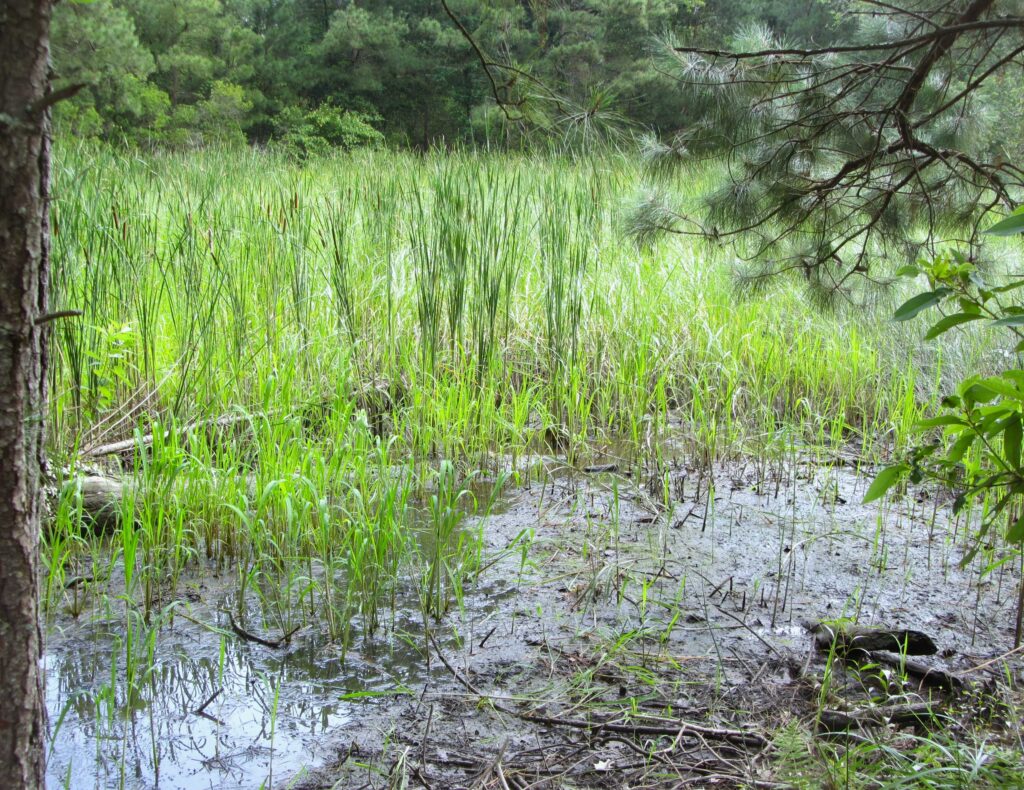
Cattails provide habitat for a variety of animals, may be eaten, and can also be harvested for thatching. They will spread aggressively on their rhizomes in wet soil.
The wetlands hold a variety of grasses, sedges, and reeds. Clusters of cattails, both Typha latifolia and T. angustipholia, bloom with their clusters of brown flowers at the tops of tall, green stems. Narrow leaves to about 6’-10’ tall blend with the surrounding grasses and rushes.
Parts of the cattail are edible, particularly their rhizomes and young shoots in the spring. Even the pollen can be eaten as flour. A casual observer might not realize that the felted brown tops of these plants are flowers. The male flowers at the top of each stalk fade away once fertilization occurs, with the female flowers remaining through the summer. Cattails spread on their rhizomes and grow quickly in moist soil. They tolerate brackish water, flooding, and saturated soil. Cattails provide materials for nests and cover for birds and small animals.
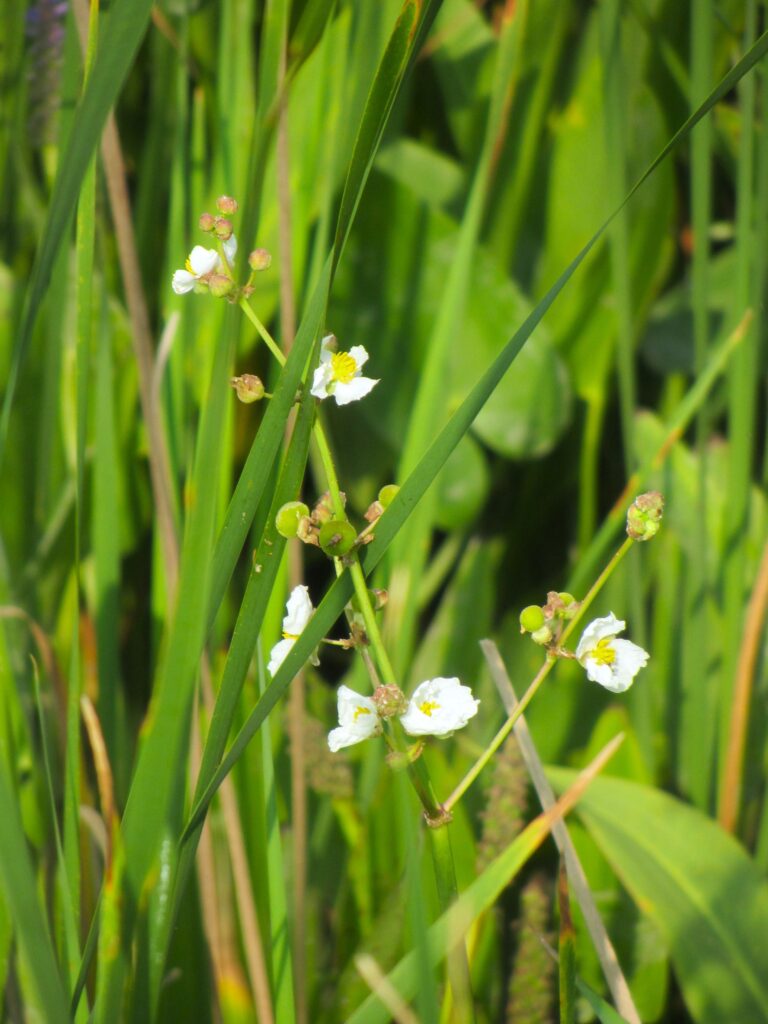
Sagittaria lancifolia, duck potato, attract pollinators to their flowers from May or June through August. Their tubers are edible.
Stalks of white flowers emerge among the cattails in late summer. Sagittaria lancifolia subsp. media, Duck potato or lance-leaved arrowhead also have edible tubers. They need their roots and rhizomes submerged at all times, and they can tolerate brackish tidal waters.
You will see these white flowers shining within a sea of green foliage on each side of many of the bridges across island waterways. They stand about 18”-36” tall in late summer and die down in the winter. Waterfowl also peck at their tubers, and a variety of insects feed from their flowers.
Stalks of purple flowers, Pontederia cordata, pickerelweed, also arise in the tidal wetlands on the island. Sometimes they appear on the shores of the island and its swamps, and other times in the middle of shallow waters. Rhizomes spread to form rounded clumps of expanding leaves and flowers. They prefer to grow in about 12” of water but can withstand periods of deeper flooding. They grow to around 4’ tall in full to partial sun. Flowers bloom over a long season from summer through fall. Their flowers support a variety of native bees, butterflies, and other insects. Dragonflies and damselflies lay eggs on their stems. Fish find shelter among their roots and rhizomes and ducks eat their seeds. This is a ‘wildflower’ that can be grown in rain gardens and water features in home gardens. Seeds are edible for people, raw or dried, and young leaves may be eaten raw I salads.
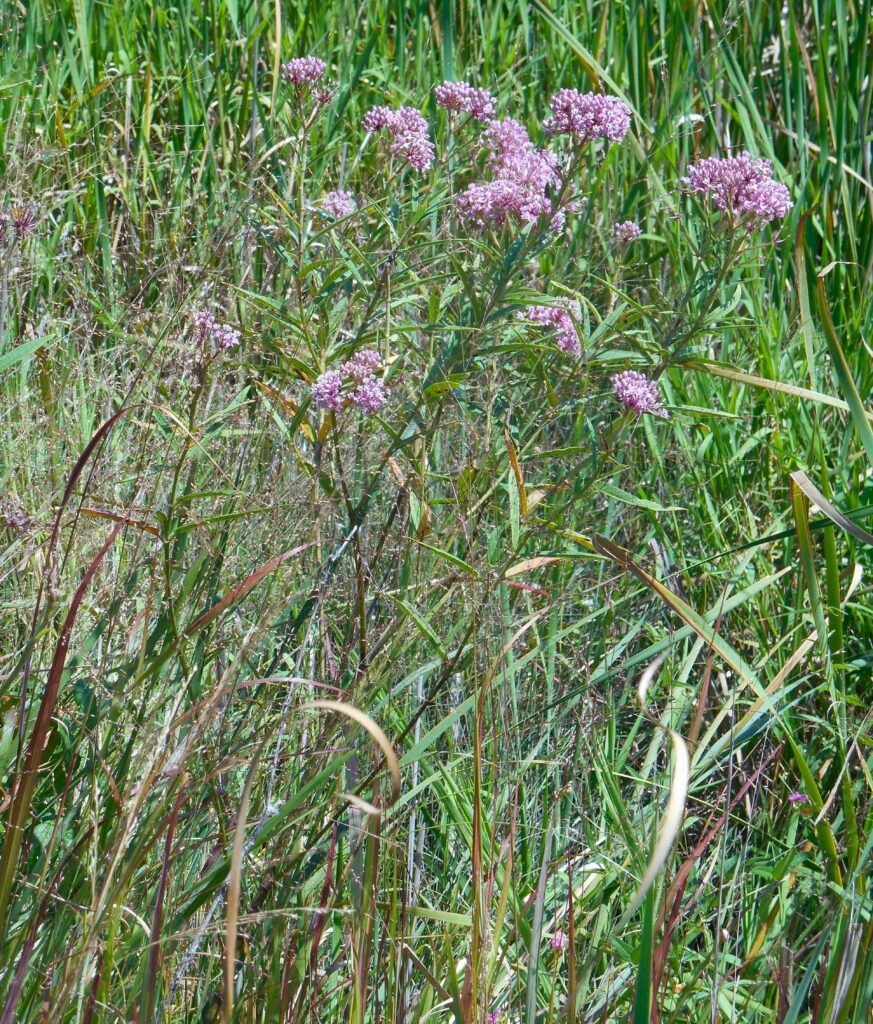
Swamp milkweed is a host for monarch butterflies. Recognize this species by its pink flowers and preference for wet soils.
Swamp milkweed, Asclepias incarnata, blooms over a long season with pink flowers. Its flowers attract a variety of pollinators and birds will eat its seeds in autumn. This is a host plant for monarch butterflies and all parts of the plant are poisonous. Swamp milkweed prefers wet soils and will grow in the marsh or beside a ditch, but it is adaptable to drier soils in gardens or pastures. It grows to 4’-5’ tall and 3’ wide.
A variety of wildflowers grow among thick stands of ferns along the sides of the loop road when the National Park Service leaves the roadsides unmown. By August, yellow, orange, white, pink, and purple flowers bloom on the island.
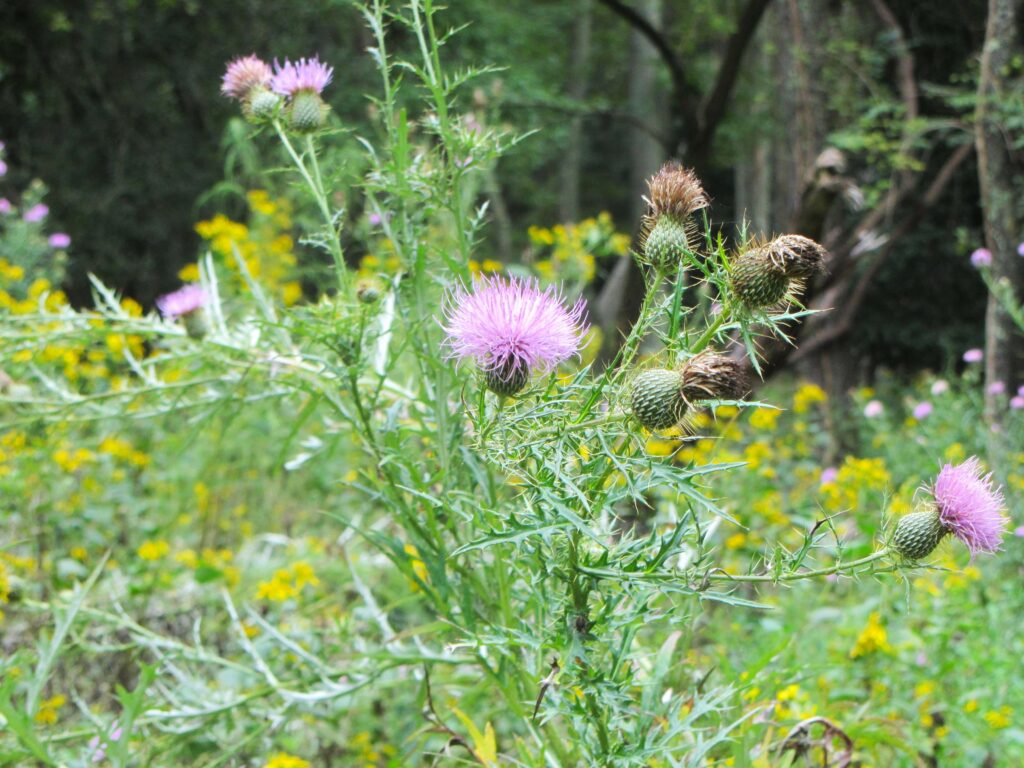
Fragrant thistle, Cirsium pumilum, attracts native bees, hummingbirds, butterflies, and other pollinators when in bloom. Birds feed on its seeds into the winter. It grows here near the old Travis homesite in the summer of 2023, along with yellow crownbeard, Verbesina occidentalis.
Keep your distance from fragrant thistle, Cirsium pumilum, if you spot it growing along the roadside or at the old Travis home site. Its leaves are clothed in sharp prickles. This striking biennial in the Aster family grows to 3′ tall. Look for this plant in relatively dry, poor soil where it receives full to partial sun. Fragrant thistle blooms in its second or third year before dying, but its abundant seeds cause it to spread to nearby areas. This native thistle naturalizes easily in areas left unmown through the season, and is a very high-value plant for wildlife. Birds not only eat its seeds but also use the tufts of its seeds to line their nests. It is a host plant for some butterflies, and a favorite for many different pollinators.
Hyssop-leaved bonset, Eupatorium hyssopifolium, produces large clusters of white flowers from late summer through fall in full to partial sun. These flowers, a member of the Aster family, serve as magnets for pollinators. Growing to 3′ tall in sandy or gravely soil, this wildflower can grow on drier soils, but tolerates sometimes moist soil. It grows in cleared areas under pines on the island
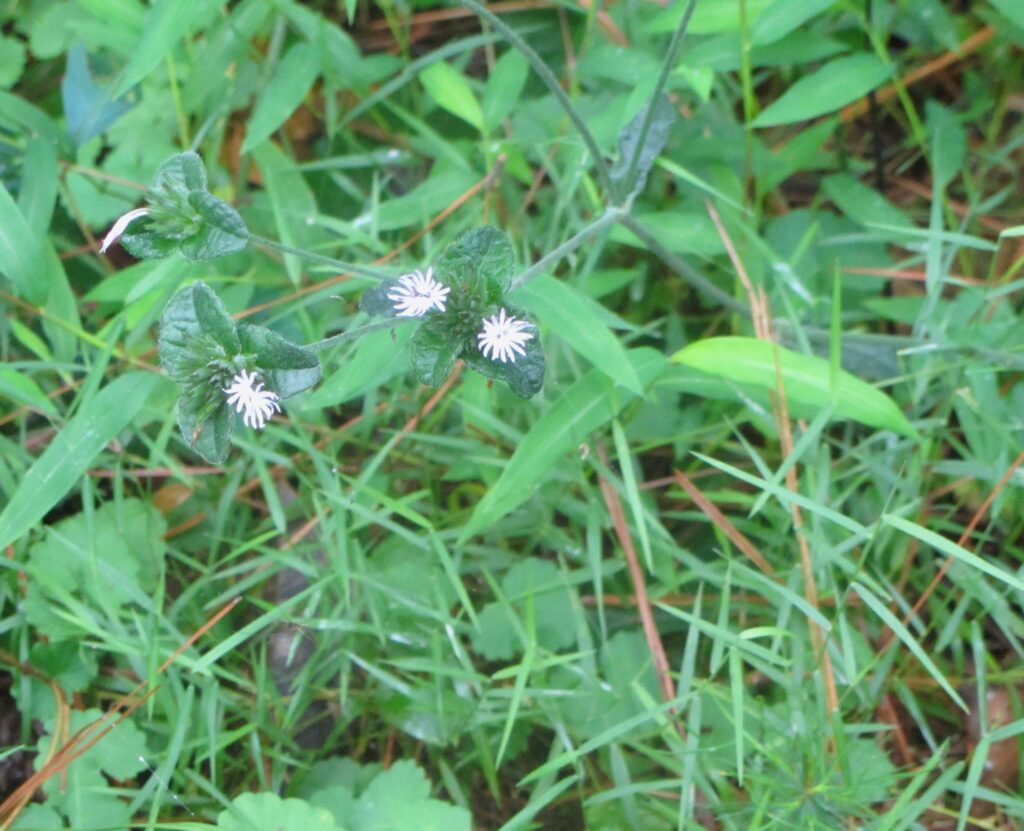
Elephant’s foot is hardly noticeable among the grasses. Most of its leaves are all at ground level, and only its stems and sparse flowers rise above other vegetation.
Tiny purple or pink flowers bloom on low growing plants whose broad, oval basil leaves remind one of a large elephant’s foot. Elephants foot, Elephantopus tomentosus, is also a member of the Aster family. Leaves emerge by early summer, but the sparse flowers don’t appear until August. These wildflowers grow from rhizomes and reseed freely.
It took years for me to realize that these are native wildflowers rather than weeds in my own yard, but I have learned to appreciate them as a ground cover when they aren’t in bloom. The stems which support the flower may grow 18”-24” tall, but this plants leaves remain at ground level. Growing among ferns, the little flowers glow, and the plant’s structure remains almost invisible. These flowers support a variety of pollinators in poor soil and partial shade. Wildlife may sometimes eat their leaves, and the plant has some medicinal uses.
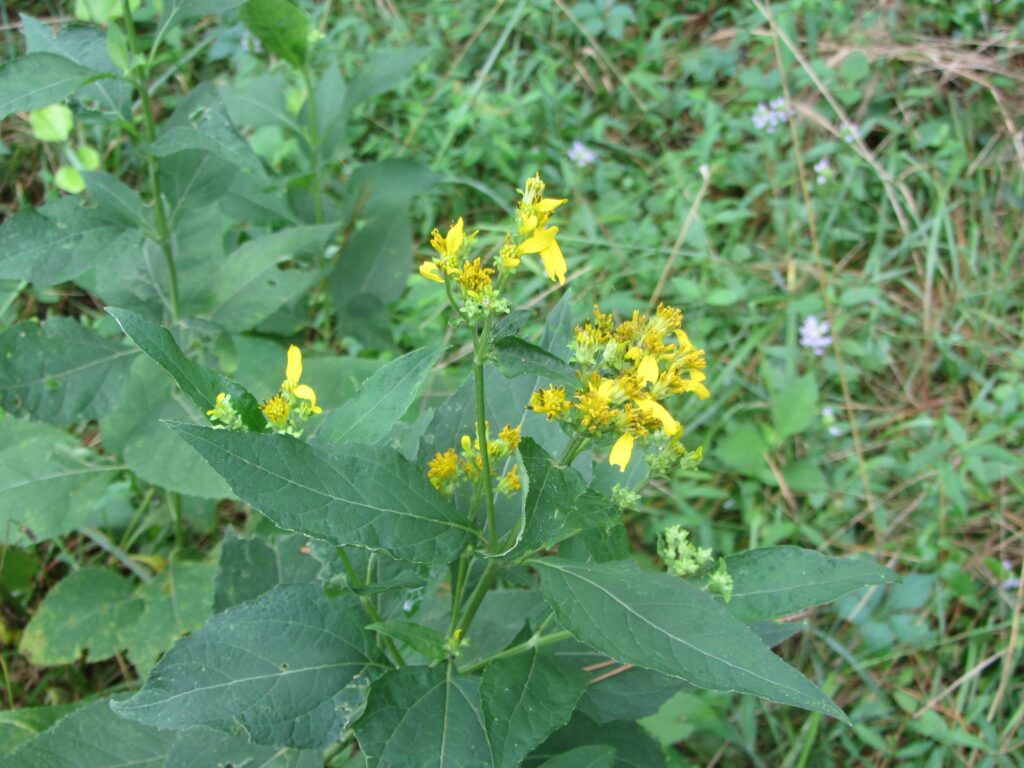
Yellow crownbeard may be found along roadsides and in clearings in many different areas on Jamestown Island.
Yellow crownbeard, Verbesina occidentalis, is another member of the Aster family that prefers wet soil. It can be found alongside ditches, in the edges of wetlands, and in moist pastures growing in full to partial sun. Yellow crownbeard feeds a variety of pollinators, and it attracts soldier beetles which attack aphids. Clumps can grow to 8’ tall.

Yarrow is both edible and medicinal in small quantities, but it can cause stomach upset when too much is taken.
Yarrow, Achillea millefolium, is a member of the Aster family and a medicinal herb considered native in Europe and naturalized in North America. It can be found growing on the island’s roadsides today. It was probably introduced later by the colonists, yet Native Americans found many healing uses for it. Its leaves are edible raw or cooked and can be made into tea. Flowers attract many pollinators. Yarrow spreads on its rhizomes and reseeds freely. It prefers full to partial sun.
The Carolina wild-petunia, Ruellia caroliniensis, supports pollinators and serves as a host plant for the Common Buckeye butterfly. It will grow 1′-3′ in partial shade on moist, acidic soil. This native is so easy to grow that some may consider it a weed.

Halberdleaf Hibiscus may be recognized by its narrow, lobed leaves. Notice the stem with seedpods from a previous year, still visible among this year’s flowers. This is a beautiful plant that is easy to cultivate at home wherever the soil is moist to occasionally wet.
A final native herbaceous flower blooming on the island in summer is Hibiscus laevis, the halberdleaf Hibiscus. This is one of several native Hibiscus species native to our area but has the smallest, narrowest leaves of Virginia’s native species. It blooms in pink or white, and its woody seedpods and dried stems often persist into the following season. It is an important nectar plant for pollinators, including hummingbirds. Birds feed on its seeds through the winter, and deer may browse its leaves. It can grow to 6′ tall and 3′ wide in full sun with plenty of moisture and rich soil.
Invasive Wildflowers
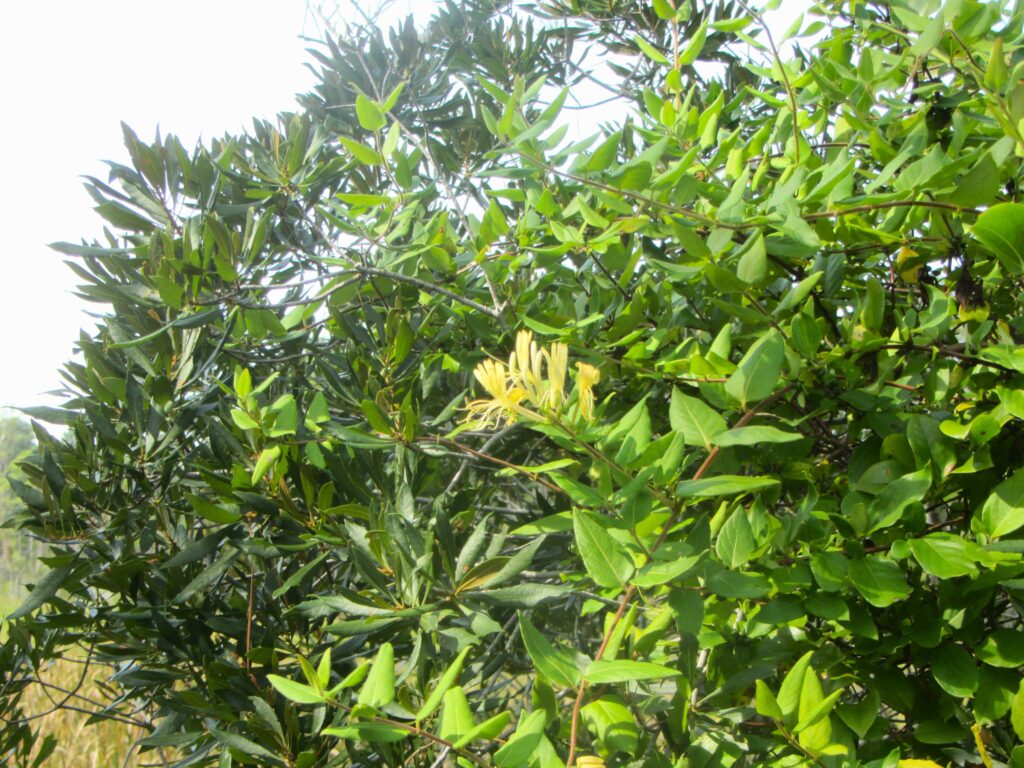
Japanese honeysuckle, Lonicera japonica, is a common Asian vine considered invasive because it out competes and sometimes smothers native plants. It is highly adaptable to many types of soil and growing conditions. It is growing here on Myrica pensylvanica, Northern wax myrtle. All species of honeysuckle attract pollinators. Rabbits and birds eat their seeds. They provide habitat for birds and insects, and their stems may be woven into baskets and other items.
A few invasive plants have naturalized on the island. Japanese stilt grass, Microstegium vimineum, grows along roadsides and in open clearings throughout the island, frequently crowding out and shading wildflowers and ferns. Japanese honeysuckle, Lonicera japonica, also scampers over shrubs, blooming throughout the summer. Pollinators visit its flowers, and many people may not recognize this common vine as invasive.
Japanese Sweet Autumn Clematis, Clematis terniflora, is perhaps the prettiest of the invasive plants blooming each summer on Jamestown Island from late July through September. Its tiny, pure white flowers open in full to part sun where its vines scamper over shrubs and up the trunks of trees.
Sweet autumn Clematis, which is highly poisonous, mimics the appearance of our native Virgin’s Bower, Clematis virginiana, which has nearly identical flowers. One must look at the leaves to tell the difference in these similar species. The native Clematis has compound deciduous leaves, while the invasive Clematis has glossy, semi-evergreen elliptical leaves with smooth margins. Both types of Clematis attract numerous pollinators and birds spread their seeds. Native Americans found many medicinal and ritual uses for C. virginiana.
Visitors to Jamestown Island will find a wide variety of native plants growing throughout the year. Even in mid-winter, there is much to see and to enjoy. But late summer is a special time to enjoy a beautiful, fascinating, and historic site.
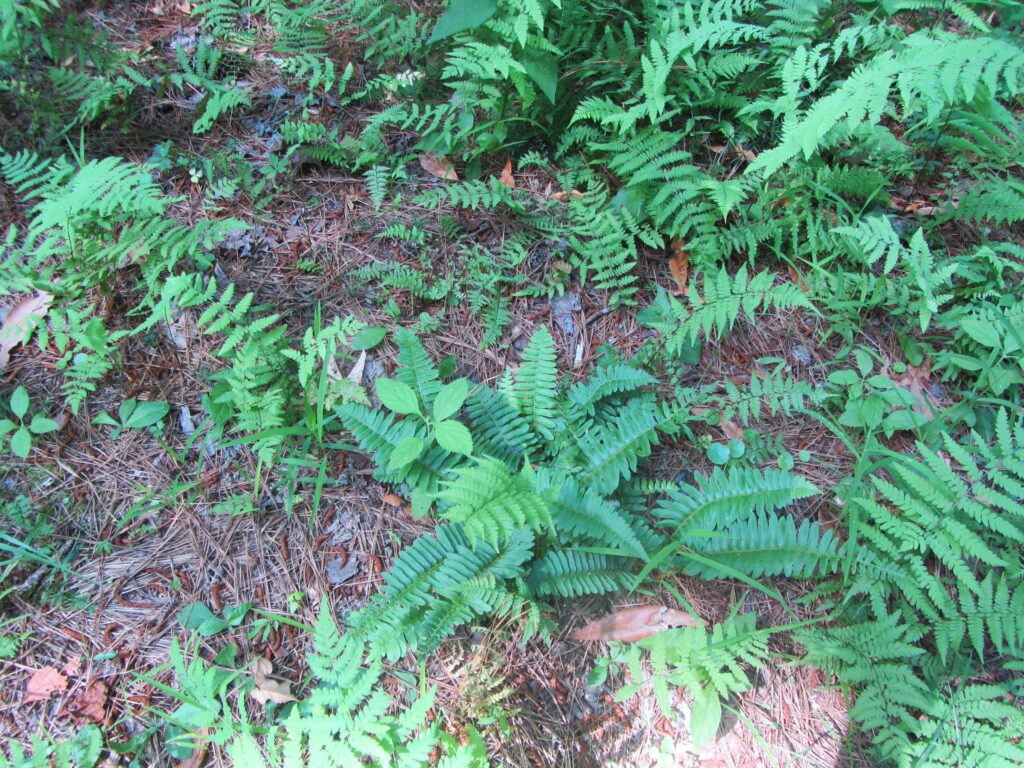
Evergreen Christmas ferns, Polystichum acrostichoides, grow among a variety of lighter colored, deciduous ferns beside the island’s Loop Road. Christmas ferns grow across the island, mostly on the higher elevations, as ground cover under mature trees.
With appreciation to botanist Dr. Donna Ware for her assistance in correctly identifying some of these wildflowers, and for providing a reference to Lynn Loetterle’s Master’s Thesis which was so helpful in writing this article.
With appreciation also to archeologist Merry Outlaw, who provided a reference to Dennis Blanton’s article about early habitation of Jamestown Island.
All photos by E. L. McCoy
For more information:
Bailey, Chuck. “Jamestown and Geodiscovery.” The William and Mary Blogs. January 23, 2024. Accessed 8.17.24. https://wmblogs.wm.edu/cmbail/jamestown-and-geodiscovery
Blanton, Dennis B. “Jamestown’s Environment.” Virtual Jamestown, Jamestown Interpretive Essays. Accessed 8.20.24. http://www.virtualjamestown.org/essays/blanton_essay.html
Loetterle, Lynn Ellen. “The Vascular Flora of Jamestown Island, James City County, Virginia” (1970). Dissertations, Theses, and Masters Projects. William & Mary. Paper 1539624684. https://dx.doi.org/doi:10.21220/s2-av0t-6s47
Smith, John. Works, 1608-1631. Edward Arber, editor. Archibald Constable and Co., Westminster. 1895.
Stebbins, Sarah J. “Chronology of Powhatan Indian Activity.” Historic Jamestowne, part of the Colonial National Historical Park Virginia. May 2009, updated August 24, 2020. Accessed 8.17.24. https://www.nps.gov/jame/learn/historyculture/chronology-of-powhatan-indian-activity.htm

